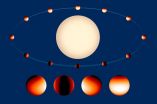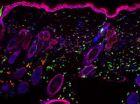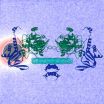WASP-43b WASP-43b is a planet the size of Jupiter but with double the mass and an orbit much closer to its parent star than any planet in the Solar System. It has one of the shortest years ever measured for an exoplanet of its size -- lasting just 19 hours.
A team of astronomers working on two companion studies have now created detailed weather maps of WASP-43b. One study mapped the temperature at different layers in the planet's atmosphere, and the other traced the amount and distribution of water vapour within it -- detail is shown in the video created by the team.
"Our observations are the first of their kind in terms of providing a two- dimensional map of the planet's thermal structure," said Kevin Stevenson from University of Chicago, USA, lead author of the thermal map study. "These maps can be used to constrain circulation models that predict how heat is transported from an exoplanet's hot day side to its cool night side."
The planet has different sides for day and night because it is tidally locked, meaning that it keeps one hemisphere facing the star, just as the Moon keeps one face toward Earth. The Hubble observations show that the exoplanet has winds that howl at the speed of sound from a day side that is hot enough to melt iron -- soaring above 1500 degrees Celsius -- to the pitch-black night side that sees temperatures plunge to a comparatively cool 500 degrees Celsius.
To study the atmosphere of WASP-43b the team combined two previous methods of analysing exoplanets for the first time.
By looking at how the parent star's light filtered through the planet's atmosphere -- a technique called transmission spectroscopy -- they determined the water abundance of the atmosphere on the boundary between the day and night hemispheres.
In order to make the map more detailed the team also measured the water abundances and temperatures at different longitudes. To do this they took advantage of the precision and stability of Hubble's instruments to subtract more than 99.95% of the light from the parent star, allowing them to study the light coming from the planet itself -- a technique called emission spectroscopy. By doing this at different points of the planet's orbit around the parent star they could map the atmosphere across its longitude.
"We have been able to observe three complete rotations -- three years for this distant planet -- during a span of just four days," explained Jacob Bean from the University of Chicago, USA, leader of the research project. "This was essential in allowing us to create the first full temperature map for an exoplanet and to probe its atmosphere to find out which elements it held and where."
Finding the proportions of the different elements in planetary atmospheres provides vital clues to understanding how planets formed.
"Because there's no planet with these tortured conditions in the Solar System, characterising the atmosphere of such a bizarre world provides a unique laboratory with which to acquire a better understanding of planet formation and planetary physics," said Nikku Madhusudhan of Cambridge University, UK, co-author of both studies. "In this case the discovery fits well with pre-existing models of how such planets behave."
The team found that WASP-43b reflected very little of its host star's light. An atmosphere like that on Earth, with clouds that reflect most of the sunlight, is not present on WASP-43b, but the team did find water vapour in the planet's atmosphere.
"The planet is so hot that all the water in its atmosphere is vapourised, rather than condensed into the icy clouds we find on Jupiter," said team member Laura Kreidberg of the University of Chicago, lead author of the study mapping water on the planet. Kreidberg describes both results in her online video.
Water is thought to play an important role in the formation of giant planets. Astronomers theorise that comet-like bodies bombard young planets, delivering most of the water and other molecules that we observe. However, the water abundances in the giant planets of the Solar System are poorly known because water is locked away as ice, deep in their atmospheres which makes it difficult to identify.
"Space probes have not been able to penetrate deep enough into Jupiter's atmosphere to obtain a clear measurement of its water abundance. But this giant planet is different," added Derek Homeier of the École Normale Superieure de Lyon, France, co-author of the studies. "WASP-43b's water is in the form of a vapour that can be much more easily traced. So we could not only find it, we were able to directly measure how much there is and test for variations along the planet's longitude."
In WASP-43b the team found the same amount of water as we would expect for an object with the same chemical composition as the Sun.
"This tells us something fundamental about how the planet formed," added Kreidberg. "Next, we aim to make water-abundance measurements for different planets to explore their chemical abundances and learn more about how planets of different sizes and types come to form around our own Sun and the stars beyond it." [1]
The results are presented in two new papers, one on the thermal mapping of the planet's atmosphere -- published online in Science Express on 2 October -- and the other on mapping the water content of the atmosphere -- published in The Astrophysical Journal Letters on 12 September 2014.
INFORMATION:
Hubble's planned successor, the James Webb Space Telescope, will be able to not only measure water abundances, but also the abundances of carbon monoxide, carbon dioxide, ammonia and methane, depending on the planet's temperature.
The Hubble Space Telescope is a project of international cooperation between ESA and NASA.
The international team of astronomers in these two studies consists of: L. Kreidberg (University of Chicago, USA); J. Bean(University of Chicago, USA); J-M. Desert (University of Colorado, USA); M.R. Line (University of California, USA); J.J. Fortney(University of California, USA); N. Madhusudhan (University of Cambridge, UK); K.B. Stevenson (University of Chicago, USA); A.P. Showman (The University of Arizona, USA); D. Charbonneau (Harvard University, USA); P.R. McCullough (Space Telescope Science Institute, USA); S. Seager (Massachussetts Insitute of Technology, USA); A. Burrows (Princeton University, USA); G.W. Henry (Tennessee State University, USA), M.Williamson(Tennessee State University, USA); T. Kataria (The University of Arizona, USA) & D. Homeier (CRAL/École Normale Superieure de Lyon, France).
More information
Links
Images of Hubble - http://www.spacetelescope.org/images/archive/category/spacecraft/
STScI release - http://hubblesite.org/newscenter/archive/releases/2014/28
Water vapour mapping science paper pdf - http://www.spacetelescope.org/static/archives/releases/science_papers/heic1422a.pdf
Water vapour mapping science paper in The Astrophysical Journal Letters - http://iopscience.iop.org/2041-8205/793/2/L27/
Thermal mapping science paper pdf - http://www.spacetelescope.org/static/archives/releases/science_papers/heic1422b.pdf
Time-lapse video of WASP-43b over one planet rotation - http://astro.uchicago.edu/~kbs/wasp43b.html
Kreidberg video describing the results - http://www.youtube.com/watch?v=tQZqAVhUk9E&feature=youtu.be
Contacts
Derek Homeier
CRAL/École Normale Supérieure de Lyon
Lyon, France
Tel: + 33 47272-8894
Cell: +33 695 57 63 55
Email: derek.homeier@ens-lyon.fr
Nikku Madhusudhan
University of Cambridge, United Kingdom
Tel: +1 617 475 5112
Cell: +44 7804 419140
Email: nmadhu@ast.cam.ac.uk
Kevin Stevenson
University of Chicago, USA
Tel: +1 407-668-5698
Email: kbs@uchicago.edu
Laura Kreidberg
University of Chicago, USA
Email: kreidberg@uchicago.edu
Jacob Bean
University of Chicago, USA
Tel: +1 773 702 9568
Email: jbean@oddjob.uchicago.edu
Georgia Bladon
ESA/Hubble, Public Information Officer
Garching, Germany
Tel: +44 7816291261
Email: gbladon@partner.eso.org



